
Common Snake Species in Wilmington
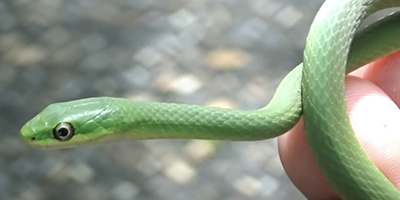 Northern rough green snake:
The northern rough green snake is a small to average-sized snake. It is slender and known for the bright green scales on the top of its body. The bright green scales make the northern rough green snake standout and hence, where it gets its name. When you observe the northern rough green snake ventrally, it is uniformly colored throughout in either green, cream, or yellow. The dorsal scales are not smooth which results in 17 keeled scales in the middle of the body. Adults can grow up to 4 feet; it has a very long tail since it takes up 1/3 of its entire length. There is not much difference in appearance between male and female northern rough green snakes and size is the only factor that differentiates them.
Northern rough green snake:
The northern rough green snake is a small to average-sized snake. It is slender and known for the bright green scales on the top of its body. The bright green scales make the northern rough green snake standout and hence, where it gets its name. When you observe the northern rough green snake ventrally, it is uniformly colored throughout in either green, cream, or yellow. The dorsal scales are not smooth which results in 17 keeled scales in the middle of the body. Adults can grow up to 4 feet; it has a very long tail since it takes up 1/3 of its entire length. There is not much difference in appearance between male and female northern rough green snakes and size is the only factor that differentiates them.
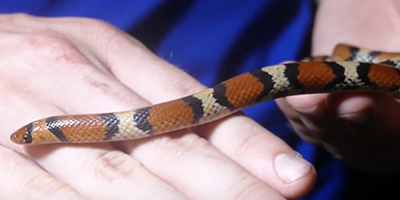 Scarlet snake:
The scarlet snake is generally considered to be a small snake of only 14-26 inches. Dorsally, the scarlet snake has a pattern and is of light gray color surrounded by blotches around the borders in red or black. The belly of the scarlet snake is uniformly white and light gray. The blotches run down the side of the scarlet snake.
Scarlet snake:
The scarlet snake is generally considered to be a small snake of only 14-26 inches. Dorsally, the scarlet snake has a pattern and is of light gray color surrounded by blotches around the borders in red or black. The belly of the scarlet snake is uniformly white and light gray. The blotches run down the side of the scarlet snake.
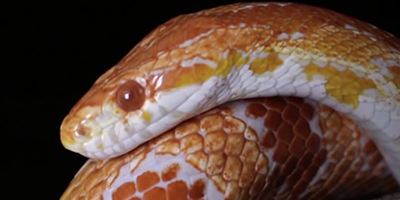 Corn snake:
Corn snakes are very thin and slender snakes (24-72 inches) that are usually orange or brown. The patterns on their body resemble that of blotches which are bright red and run down the corn snake's back. They are often known as red rat snakes. Under their bodies, towards their belly is a prominent checkered pattern that is formed through multiple rows of black and white lines and marks. One factor to note is that the pattern and color of corn snakes depend on the age and the location of the corn snake. Young corn snakes are generally not as bright as adult corn snakes. Corn snakes are generally the most active during the day and hunt during this time.
Corn snake:
Corn snakes are very thin and slender snakes (24-72 inches) that are usually orange or brown. The patterns on their body resemble that of blotches which are bright red and run down the corn snake's back. They are often known as red rat snakes. Under their bodies, towards their belly is a prominent checkered pattern that is formed through multiple rows of black and white lines and marks. One factor to note is that the pattern and color of corn snakes depend on the age and the location of the corn snake. Young corn snakes are generally not as bright as adult corn snakes. Corn snakes are generally the most active during the day and hunt during this time.
Venomous Snake Species in Wilmington
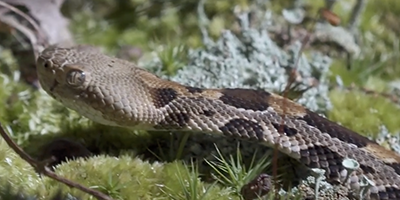 Timber Rattlesnake:
The timber rattlesnake is a venomous snake that can vary in its color; it can be gray with tones of pink and can also have a stripe that runs smoothly and finely down the snake's back. The color of the stripe can have variations, it can be orange, pink, and even yellow. Some timber rattlesnakes just have a dark black or brown fine stripe on their body hence, showcasing a varying trend in their color along with the color of the stripes. At the tip of its tail, the rattlesnake has a rattle that comes to attention as soon as it feels a threat nearby; this results in a rattle-like sound. The sound can be heard before the timber rattlesnake decides to strike, however, usually in most cases it does not strike and remains docile. Even though they do not bite often, a person needs to see a doctor immediately if bitten by a timber rattlesnake as the venom can be lethal if not treated medically on an immediate basis.
Timber Rattlesnake:
The timber rattlesnake is a venomous snake that can vary in its color; it can be gray with tones of pink and can also have a stripe that runs smoothly and finely down the snake's back. The color of the stripe can have variations, it can be orange, pink, and even yellow. Some timber rattlesnakes just have a dark black or brown fine stripe on their body hence, showcasing a varying trend in their color along with the color of the stripes. At the tip of its tail, the rattlesnake has a rattle that comes to attention as soon as it feels a threat nearby; this results in a rattle-like sound. The sound can be heard before the timber rattlesnake decides to strike, however, usually in most cases it does not strike and remains docile. Even though they do not bite often, a person needs to see a doctor immediately if bitten by a timber rattlesnake as the venom can be lethal if not treated medically on an immediate basis.
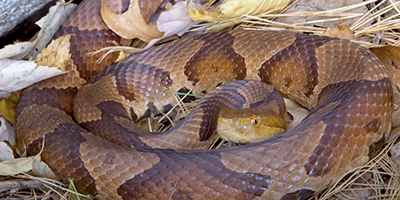 Northern copperhead:
Northern copperheads are snakes that are known for their thick bodies and not so smooth scales. They have no patterns or markings on their head like most snakes. They are rather plain with their copper-colored bodies and crossbands. Interestingly, their crossbands are shaped like an hourglass which makes their crossbands standout and look prominent on their copper-colored skin. The northern copperhead has one standalone row of scales. Northern Copperheads have fangs through which they release venom to weaken their prey. The larger the snake is the larger its fangs will be.
Northern copperhead:
Northern copperheads are snakes that are known for their thick bodies and not so smooth scales. They have no patterns or markings on their head like most snakes. They are rather plain with their copper-colored bodies and crossbands. Interestingly, their crossbands are shaped like an hourglass which makes their crossbands standout and look prominent on their copper-colored skin. The northern copperhead has one standalone row of scales. Northern Copperheads have fangs through which they release venom to weaken their prey. The larger the snake is the larger its fangs will be.